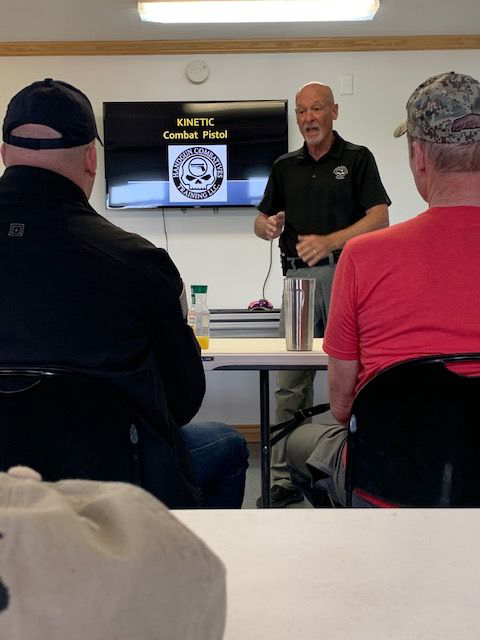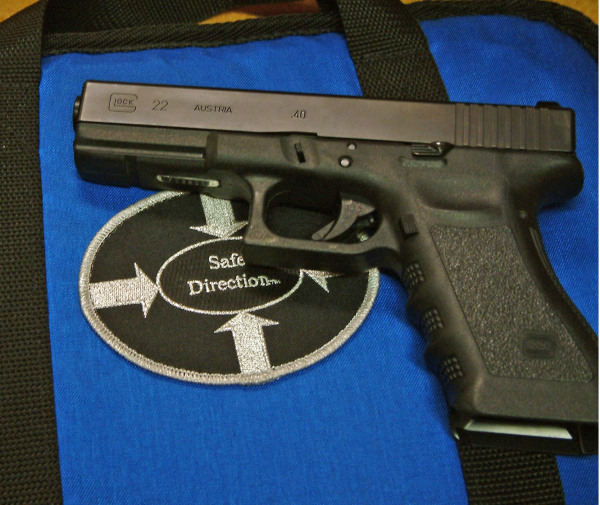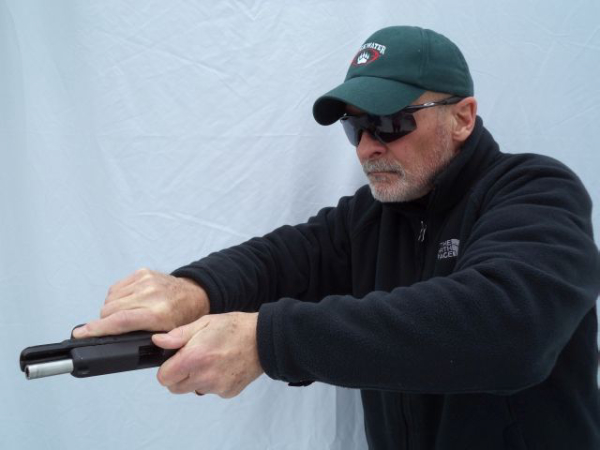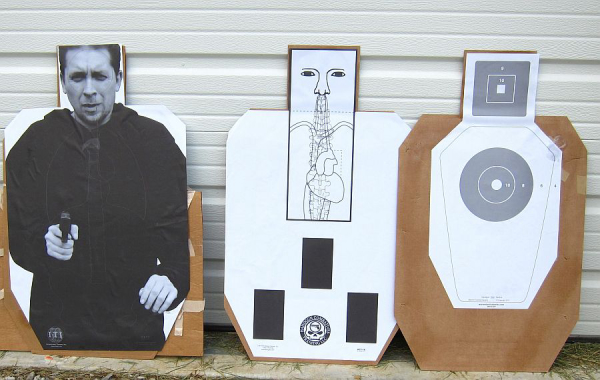Today’s feature is from correspondent Dave Spaulding. Soon to retire from his training business, he launches a parting shot.

Photo by Greg Moats
|
One of the most common questions I receive from readers or students is, “What should I practice?”
There is no doubt that ammo prices (and availability) affect one’s personal training and the ability to keep one’s skills sharp while paying the mortgage, car payment, buying groceries, clothing and all the other things necessary for daily life. Since blowing up ammo needlessly is certainly recognized as expensive, we need to shoot our limited ammo supply wisely...as well as use our valuable time wisely.
I’m a firm believer in essential skills (what most call fundamentals), and while many shooters get bored practicing basics, these skills are necessary to prevail in a fight. Bruce Lee said, “Advanced skills are the basics mastered,” and it is so true. My research into armed conflict along with my law enforcement experience has led me to believe pistol fights are not complicated affairs…they are quite straight forward, really. Seldom are barrel rolls and related acrobatics necessary, they are usually “go to guns” fast and furious with a bit of movement. Many USPSA matches are much more complicated. Thus, practicing basics is a great place to start.
Dry Fire

Fortunately, most all essential skills are mastered without firing a shot. Dry fire is the best way to improve draw, reload, malfunction clearances (using dummy rounds), shooting around cover (with a mirror at the opposing side to see how much you expose of yourself), one-hand manipulation, unconventional shooting positions (kneeling, prone, on the side, “roll back”, etc.) and any other skill that doesn’t require actual repeated trigger manipulation. The purchase of a dry fire training aid can give first shot feedback via a laser fit into the barrel of your carry gun. In truth, repeated trigger and recoil control are the only things that require live ammo expenditure.
Before beginning any dry fire training program, make double, triple and quadruple sure that your gun is empty and that no live ammo is in the room with you. As a matter of fact, it is a great idea to make sure you are in the room alone and lock the door behind you, especially if you have small children. A capable dry fire pad, such as the one manufactured by Safe Direction, is a very good idea. An old body armor panel will also work. That way, if you suffer a “brain fart,” the round will be captured harmlessly and a valuable lesson learned.
The Real Deal

Now that we’ve narrowed the skills needed for live fire practice, let’s look at when we do need live ammo. Trigger control is the most important skill required for accurate shooting and the most difficult to master. In a nutshell, the index finger on the shooting hand depresses the trigger to the rear, working independently of the rest of the hand, without interrupting muzzle-to-target alignment. Think about how many times a day you open and close your hand, using the thumb and fingers in concert with one another -- then you can get some idea of how complex this action really is. You are actually trying to combat thousands of repetitions a day of an action with occasional range practice. Taking this into consideration, is it really hard to understand why shooters squeeze their whole hand when they shoot, something I call “milking the grip” as it reminds me of my feeble attempt to milk the teat on a cow in my past…squeeze and pull down. Sound familiar? Do you squeeze the whole hand when you shoot? Most do...
Independent trigger manipulation requires intense concentration and needs to be mastered before all other skills. It must be practiced regularly, as it will diminish quickly. Keep in mind, every time you open and close your hand you are actually “un-practicing” the independent use of the index finger.
On the Range

With the previous thoughts in mind as I head to the range, I start out with a few timed drills to see where I’m at. I do these drills “cold,” as I believe they are a better indicator of performance than after I have shot for a while. Remember, it’s unlikely you’ll have just come from a practice session at the range when your gunfight occurs. You’ll more than likely be “cold” as well.
I shoot these drills at 20 feet on the 6 x 9-inch chest cavity overlay which you can print off the Handgun Combatives website. Only hits in this chest cavity count. I consider live fire a confirmation of the dry practice drills. I do each drill twice—anyone can get lucky and perform a single session well. One after another is more telling.
These are the drills I perform:
These drills take 15 minutes and consume less than 20 rounds. You may decide to shorten this test to conserve ammo. To me, they give an idea of where I am lacking and what to work on. But don’t shoot any faster than you can hit! A “lucky run” isn’t educational, only deceiving. These drills should be learning points, not ego gratifiers.
Trigger Focus
I then shoot several magazines focusing on trigger control, which, as previously stated, is one area where dry fire does not suffice. I start at 15 feet, shooting 3 x 5 cards, going agonizingly slow, trying to shoot one jagged hole. I focus completely on what my hands are doing, making them control the trigger and not squeezing the entire grip, find the reset point and then smoothly pressing through the trigger action. RESET THE TRIGGER WHILE IN RECOVERY OF RECOIL! Why would you want to be on target but not ready to shoot? I also take note of my body position, making sure my shoulders are over my toes.
I move back 5 yards at a time, shooting 3 rounds at each distance, trying to stay on the 3 x 5 card, concentrating on “sight, depress.” I work my way back to 25 yards. By this time, I have fired about 30 rounds, give or take as I sometimes re-shoot a stage, so if the ammo supply is low, I stop.
More Practice
If I have additional ammo available, I then work on PLACING the gun on the target from the holster, ensuring the delivery is consistent and feels smooth…no bounce at the end. The felt aspects of shooting are grossly under-rated. Think of the draw stroke as an upside-down L with the gun coming up from the holster, turning, and going directly to the target. A good draw is one that arrives where you are looking...where you need it! I will use a two- inch, stick on dot to enhance muzzle placement. I want the sight to arrive on the dot.
Lateral movement can be part of this drill and I try to move until I am ready to shoot…somewhere around 10 feet. I also work on picking up the front sight in my field of vision as quickly as possible. Make sure you practice with the same carry gear that you use daily, including a concealing garment. At this point, I will have shot around 50 rounds, give or take.
These drills do not account for all of what might happen in a gunfight, but understand there’s no way to prepare for every potential conflict. History has shown that the person who prevails in armed conflict is the one who can keep his/her head and decide which of their practiced skills will solve the problem at hand. You must be aware, adapt and apply. The student who never practices is the one who will fail to decide. Stay safe, stay alert and practice your skills often.
Dave Spaulding is a professional firearms instructor with 36 years' experience in Law Enforcement and Federal Security. The recipient of the 2010 Law Enforcement Trainer of the Year Award from the International Law Enforcement Training and Educators Association (ILEETA), Dave has worked in all facets of law enforcement including communications, corrections, court security, patrol, evidence collection, training and investigations. He was a founding member of his agency’s SWAT Team and acted as its training officer for 8 years. He spent a year in an undercover capacity and was the commander of a multi-jurisdictional narcotics task force, has been an adjunct instructor at the former Heckler & Koch International Training Division and the Tactical Defense Institute. In addition to his many published articles (over 1,400), Dave is the author of two acclaimed books, Defensive Living and Handgun Combatives. He still operates his own training company that focuses exclusively on “the combative application of the handgun” www.handguncombatives.com .